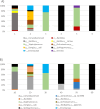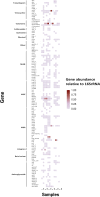The bacterial microbiome and resistome of house dust mites in Irish homes
- PMID: 39179632
- PMCID: PMC11343766
- DOI: 10.1038/s41598-024-70686-y
The bacterial microbiome and resistome of house dust mites in Irish homes
Abstract
Dust samples were collected from Irish homes. House Dust Mite and storage mites were separated from the dust. The microbiome and resistome of mites and originating dust were assessed using a culture-independent approach. The bacterial microbiome of mites and dust were predominantly populated by Staphylococci. There was a highly significant (P = 0.005; Spearman's rank test) correlation between the bacterial microbiome of mites and the dust. One-hundred and eighteen antimicrobial resistance genes (ARGs) were associated with mites and 176 with dust. Both contained ARGs encoding resistance for multi drug resistances, macrolide-lincosamide-streptogramin B, mobile genetic elements, Beta-lactam, Tetracycline and Aminoglycosides. By contrast, 15 ARGs were found for a laboratory-grown strain of Dermatophagoides pteronyssinus. A significant difference (P = 0.03; t test) was found in means between the resistome of mites and the household dust from which they emanated. No significant correlations (P = 0.23 and P = 0.22; Mantel test) were observed between the microbiome and resistome of mite and dust samples. There was not a significant difference (P = 0.54; t-test) between the means of ARGs for homes with and without a history of antibiotic use.
Keywords: 16 S rRNA microbiome; Antibiotic resistant genes; Dust mites; Dust samples; Resistome; qPCR SmartChip.
© 2024. The Author(s).
Conflict of interest statement
The authors declare no competing interests.
Figures





Similar articles
-
Resistome in the indoor dust samples from workplaces and households: a pilot study.Front Cell Infect Microbiol. 2024 Dec 3;14:1484100. doi: 10.3389/fcimb.2024.1484100. eCollection 2024. Front Cell Infect Microbiol. 2024. PMID: 39691696 Free PMC article.
-
Microbiome and antibiotic resistome in household dust from Beijing, China.Environ Int. 2020 Jun;139:105702. doi: 10.1016/j.envint.2020.105702. Epub 2020 Apr 2. Environ Int. 2020. PMID: 32248025
-
The influence of household pets on the composition and quantity of allergenic mite fauna within Irish homes: a preliminary investigation.Med Vet Entomol. 2016 Mar;30(1):21-30. doi: 10.1111/mve.12147. Epub 2015 Nov 17. Med Vet Entomol. 2016. PMID: 26575784
-
Profiles of Microbial Community and Antibiotic Resistome in Wild Tick Species.mSystems. 2022 Aug 30;7(4):e0003722. doi: 10.1128/msystems.00037-22. Epub 2022 Aug 1. mSystems. 2022. PMID: 35913190 Free PMC article. Review.
-
Quantification of house-dust-mite populations.Allergy. 1998;53(48 Suppl):18-23. doi: 10.1111/j.1398-9995.1998.tb04991.x. Allergy. 1998. PMID: 10096802 Review.
Cited by
-
Update on HDM Allergy: Principal Changes over the Years.Int J Mol Sci. 2025 Jun 13;26(12):5660. doi: 10.3390/ijms26125660. Int J Mol Sci. 2025. PMID: 40565123 Free PMC article. Review.
-
Metagenomic insights into surface sediment microbial community and functional composition along a water-depth gradient in a subtropic deep lake.Front Microbiol. 2025 Jul 30;16:1614055. doi: 10.3389/fmicb.2025.1614055. eCollection 2025. Front Microbiol. 2025. PMID: 40809047 Free PMC article.
References
-
- Brasche, S. & Bischof, W. Daily time spent indoors in German homes—Baseline data for the assessment of indoor exposure of German occupants. Int. J. Hyg. Environ. Health208, 247–253 (2005). - PubMed
-
- Morawska, L. et al. Airborne particles in indoor environment of homes, schools, offices and aged care facilities: The main routes of exposure. Environ. Int.108, 75–83. 10.1016/j.envint.2017.07.025 (2017). - PubMed
-
- Viegas, C. et al. Settled dust assessment in clinical environment: Useful for the evaluation of a wider bioburden spectrum. Taylor Fr.31, 160–178 (2021). - PubMed
-
- Melymuk, L., Demirtepe, H. & Jílková, S. R. Indoor dust and associated chemical exposures. Curr. Opin. Environ. Sci. Health15, 1–6 (2020).
MeSH terms
Substances
LinkOut - more resources
Full Text Sources

